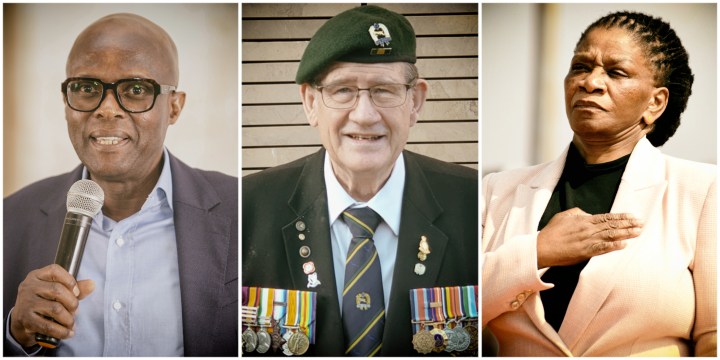VETERANS
Dysfunctional database, slow pension payout, no comms — plight of military veterans Part 1

Numerous military veterans have expressed frustration with the lack of control over the Department of Military Veterans structure and database, highlighting challenges in registering on the database and receiving benefits including pension.
“The Department of Defence and Military Veterans (DMV) as a department, is one of the worst departments in South Africa. Reports are being handed over on how bad the DMV is as a department to the parliamentary committee which just accepts these reports and still doesn’t intervene or correct it,” Godfrey Giles, who served in the South African Infantry Corps from 1968 to 2014 told Daily Maverick.
Giles is also the Vice-Chairman of the South African Military Veterans Organisation (Samvo), an ex-servicemen organisation comprised of military and police veterans who served in the South African Defence Force, South African National Defence Force, South African Police, South African Police Service, or the South African Prison Services.
Giles is one of many military veterans who have expressed frustration with the DMV regarding registering to the database and a slow rollout of pension benefit payout outs.
In February 2024, Giles sent a letter outlining his concerns to Vusumuzi Xaba, the chairperson of the portfolio committee on defence and military veterans, but received no response.
“For over a decade now we’ve been saying there are issues with the database, veterans have marched on DMV, they’ve even held the minister and others hostage in a hotel to try and get something done, and political parties have been approached to help us as far as the Parliament is concerned, but very little has happened,” he said.
Understanding the database
The initial database was established using the Central Personnel Register (CPR) consisting of some 57,000 members of the combined forces at integration in 1994, said Giles. The seven armies that were integrated were Umkhonto weSizwe (MK) and the Azanian People’s Liberation Army (APLA), the military wings of the ANC and PAC respectively; the former Bantustan Armies of Transkei, Bophuthatswana, Venda and Ciskei; and the South African Defence Force (SADF).
“Since DMV was established (in 2009), they’ve managed to put on less than 30,000 names […] I handed well over 40,000 files that have been filled in by veterans to the DMV for data capture,” said Giles.
A project was launched to invite all military veterans to apply to be registered on the DMV database. But the DMV soon realised that this was a mammoth task and did not have sufficient personnel to handle it.
“They then found that there was a lot of fraudulent stuff happening, especially about non-veterans who thought that they were part of the non-statutory forces, and it was because they didn’t have a central administration,” he said.
Statutory forces have a personnel records system where everybody who was in the military has a force number and a military record. However, non-statutory forces which are Umkhonto weSizwe and Azanian Peoples’ Liberation Army amongst others, did not have such a system or such records, said Giles.
With a large number of applications and many applicants not having the correct credentials, all applications had to be vetted. However, the DMV was not allowed to link into the SANDF Persol system that could verify the majority of applicants. Each individual now has to apply directly with the DMV to be placed on the database — a fraught process, according to Giles.
Numerous documents must be included in the application, and applicants receive no acknowledgement of receipt with a reference number.
“So you are left in the dark, and if you try to follow up, the phones are not answered, and emails are not responded to. When they don’t get a response they back through this whole process again, and get the documents certified once again, and it is a problem, especially when they [veterans] are way out in the sticks,” he said.
The DMV also requires original stamped printouts from the Persol System, which can be obtained from the SANDF.
“Now you’ve got two totally different divisions if you’d like. One is soldiers who are trying to do it, who are under budget, who are understaffed, who are pressurised to do things. Now, an old buddy comes along as a veteran and says, ‘I need these printouts from you,’ and there are about 10 printouts that they have to do, so they have to now find somebody on an army base who’s willing to help them to print out all of these documents as well,” said Giles.
There are also issues with identity document (ID) numbers. During apartheid, identification documents included a number denoting an individual’s race. This has been eliminated, and old ID numbers were reissued to remove this.
“They (DMV) are saying that they now need to have a letter from the Department of Home Affairs stating this is the old one (ID number) and this is the new one, it costs R70, and it takes months for the Department of Home Affairs to actually hand that over,” said Giles.
A South African ID number is a 13-digit number, with the first six digits based on birth date, four digits to define gender, one digit to indicate if you are a South African or a permanent resident, and the last two digits are a checksum digit used to check that the number sequence is accurate using the Luhn algorithm.
Lack of communication a major problem
Military veterans are not recognised as such until they are on the DMV database, and they cannot receive benefits unless they are registered on the database, said Giles.
According to the Military Veterans Act of 2011, a military veteran means any South African citizen who rendered military service to any of the military organisations, statutory and non-statutory forces involved in all sides of South Africa’s liberation War from 1960 to 1994, who became members of the SA National Defence Force (SANDF) after 1994.
Ernest Lintnaar who served in the SADF between 1982 and 1989 as well as with SANDF from 1994 to 1998, has been making applications to join the military veterans database since 2010.
“Between 2010 and 2015, I hand-delivered my documents to a guy called Mike Masala in Cape Town at DMV. I moved out of Cape Town, but I still kept sending my emails, and I’ve got quite a few copies of these emails,” he said.
Lintnaar said it was common to receive no communication at all from the department.
“They just don’t come back to you. We as a collective have gone to the extent that we are emailing everybody every week and we are still not getting anywhere,” he said.
Lintnaar said he knew of veterans who qualified for benefits but were unable to receive them.
“There is a guy that’s on life support. He qualifies for medical, but he is also still battling to get onto the database. He’s got to pay his medical expenses, the life support units you can imagine — 24/7 live support on oxygen — and he’s at home, he’s gonna pay for it himself,” Lintnaar said.
The lack of communication and acknowledgement when the veterans send in forms is a “major problem”.
“We have reached the point where we are so desperate that we now get people to witness the person handing it in, and we take a photograph of the person handing it in because we just told them, ‘No, the forms didn’t arrive, nobody took them in, what are you talking about?’ and there’s no acknowledgement,” said Giles.
Veterans have received SMSes on occasions stating they were on the database. However, these messages do not include their name or any other identification, making it difficult to verify this information at the DMV. Reference numbers are also not provided for future correspondence and seemingly no method is in place for veterans to track the progress of their application.
“I just feel there’s no public awareness of the progress. So there’s nothing put out by the DMV on their website that says ‘these are the numbers that we’ve added for the week of the month, these are the numbers we’ve rejected, this is the progress we’ve made’. So nobody is trusting what is actually happening with DMV at all because they’ve got nothing to gauge it by, which then builds up the perceptions that there’s discrimination between the non-statutory force and the statutory force,” said Giles.
Giles does not believe there is discrimination between the non-statutory force and the statutory force or racial prejudice.
“For instance, in the initial database of the 57,000 well over 70% were statutory force people and I also know some of the white people who have been paid out and are on the database, so that isn’t true. However, we don’t know how much has been accepted and has not been dealt with which is frustrating,” he said.
At the time of publication, DMV and GPAA had not responded to questions sent by Daily Maverick on 25 April and again on 30 April. DM
Read Part 2 of the article here.



















Still waiting for my pension
Just want to ask on the Namibians that joined the South African Defence Force and went of without getting anything example no benefits and military pension.some still has their SA Defence Force Identity Cards how can they claim their benefits and military pension?
Just another typical day in the South Africa under the useless cANCer, there is no money to loot, so why would we worry about the “old soldiers” we still get our salaries and inflated salaries at that. We can live in hope that a new goverment will be more sympathetic to the old soldier. The DMV and all the fat cats should hang their heads in shame.
Since 2022 still not received any benefits nothing even if I keep on sending still no reply